Mice are a common household pest that most homeowners will contend with at some point in their life – sometimes even repeatedly! Unfortunately, mice spell trouble for our homes for a couple different reasons. Mice are incredibly prolific breeders, multiplying seemingly by the day and therefore rarely a problem of a single mouse in the house. Secondly, mice can cause significant damage to integral parts of your home. Due to these reasons (and many more) mice are an unwelcome sight. When dealing with furry invaders, our customers often ask: “how much to get rid of these guys?!” Today, we hope to answer that question and more!
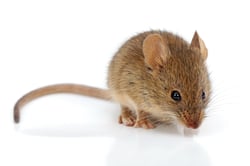
Understanding Mice and Their Lifecycle
When attempting to remove mice, it’s important to understand mice themselves, including their rapid lifecycles.
Mice are small rodent mammals of the Muroidea superfamily. Sometimes confused with rats, mice are characteristically smaller in size than a rat and are easily recognized by their pointed snout, rounded ears, and long tails. Some of the more commonly encountered mice include the aptly named house mouse, deer mouse, and white-footed mouse. All three of these mice are known for their tendency to frequent homes and personal residences. Unfortunately for homeowners, these mice, like all mice, reproduce at incredibly prolific rates. The rapid reproduction of mice should be cause for concern when you find one in your home – chances are, if there truly is just one mouse in your house, there will be many more before long.
Not only do mice reproduce expeditiously, but they can also live for a considerable amount of time if living safely indoors. Once a female mouse becomes pregnant, she will give birth in just three short weeks. Each litter can contain up to eight “pups,” and females may reproduce as many as ten times per year. The baby mice will reach maturity and be able to reproduce themselves within two months after being born. This cycle of reproduction will continue for the entirety of a mouse’s lifespan, which is approximately 2-3 years on average. Needless to say, this spells trouble for homeowners with a mouse problem.
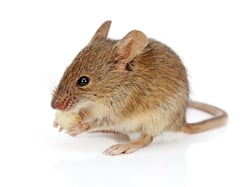
Why Do Mice Come Indoors and Where Do They Go?
Mice are particularly drawn to certain areas within a home, such as garages, ceilings, inside walls, under kitchen cabinets or fridges, and in basements or crawl spaces. These mouse “hot spots” can help determine why mice have decided to take up residence in your home. What attracts mice to heavily trafficked and clearly occupied homes? Why do they choose to stay, live, and even reproduce in homes? And why can’t you get rid of them?
While there are seemingly limitless reasons why a mouse may enter your home or garage, there are a few broadly defined causes for unwelcome rodent visitors.
Food - Whether you realize it or not, you could be unintentionally feeding the mice that make their way into your home. This is one major reason mice tend to seek out residences: unlimited food supply. Mice are hardy little creatures and can easily survive off of unnoticed crumbs and food scraps, or worse, make their way into your kitchen pantry for the real buffet. Mice are also known to help themselves to bags of grain, birdseed, grass seed, pet food, or other bulk food items that you may store in your garage. They may squeeze their way into your car in search of trash like half-empty takeout bags or dropped morsels from your morning's grab-and-go breakfast.
Water - Your home can be a reliable water source for mice. With so many rooms having access to readily available water – think kitchens, bathrooms, laundry rooms, and even garages – mice will never have to stray from the home for a quick drink. Mice are capable of going a month or more without water, and even with easily accessible water available to them, they only need about 4ml to be quenched. Because they need so little water, they can survive by finding it in unexpected ways, such as by drinking condensation from water pipes, consuming excess water from houseplants, and helping themselves to a pet’s water bowl. This means that no matter how watertight you believe your home is, a mouse can still thrive.
Shelter - The most obvious reason that mice scurry indoors is for shelter from predators and the elements. In the summertime, mice will seek shelter for a reprieve from the heat. As we cool our homes for our own comfort throughout the summer, we’re unintentionally providing a temperature-controlled environment perfect for mice to find relief in. The same can be said for the winter. Consistently warmed homes offer an escape for mice from the bitter cold and provide an excellent home base for building their nests. The constant need for comfortable and safe shelter is exactly why mice are not considered a seasonal pest but rather a year-round one. This is especially true for homes with garages, where mice can live undetected for a long time and find plenty of dark places to hide and nest.
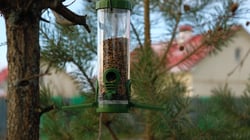 Birdseed, often stored in garages or sheds near your home, are a mouse's favorite snack.
Birdseed, often stored in garages or sheds near your home, are a mouse's favorite snack.
How Are Mice Getting Inside My House?
Something else to keep in mind when considering the cost of mice removal is if the solution will prevent further mice problems, or if it’s a temporary fix. Because mice are so small, they can gain entry through even the most unlikely of spots. Some common entry points for mice include gaps or cracks in your foundation, holes in a home’s exterior, gaps under garage doors, outside vents, or through attics and basements. You may believe that there are no holes large enough for mice to enter your home through, but this is likely not true. A mouse’s body is remarkably pliable and capable of squeezing in ways a human can't. Mice have flexible bodies that can slip through cracks as small as a quarter of an inch wide – that’s about the width of a pencil!
If these entry points aren’t identified and rectified, removing the existing mice might be a fruitless endeavor as other mice can still make their way into your home.
![]() Exterior vents are common entry points for mice and other pests.
Exterior vents are common entry points for mice and other pests.
How Much Damage Can Mice REALLY Cause?
Mice are often underestimated in their ability to wreak havoc in homes. Though small, mice can cause significant damage to your home. Perhaps most concerning of all is the structural damage mice can inflict on homes through their incessant chewing, nest-building, and defecation. Some other troublesome repercussions of a mouse infestation include:
- Burrowing into upholstered furniture and building nests inside.
- Tunneling through insulation and using the material to build softer nests.
- Gnawing the rubber insulation of wires behind walls, resulting in the potential for electrical fires.
- Chewing through and destroying expensive or sentimental items, including artwork, documents, heirlooms, books, and more.
- Their urine and droppings can stain and ruin ceilings, walls, and more. These trails also attract more mice, the scent of their defecation serving as a beacon to other rodents, saying: this is a good place to live!
The damage mice can leave in their wake isn’t limited to strictly material items, either. Mice are capable of carrying and spreading diseases that are harmful to humans. Some diseases mice are known to spread include hantavirus, salmonella, and lymphocytic choriomeningitis. These diseases are commonly spread through a mouse’s droppings. Even if you are careful to handle the droppings with gloved hands, you may still be at risk. Mice urine and droppings can dry and eventually turn to dust, then becoming airborne and leaving homeowners susceptible to breathing in harmful viruses.
It should be noted that some diseases carried by mice can also be transmitted to your pets. Humans can be vulnerable to passed viruses from cats and dogs, as well.
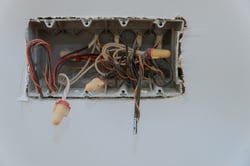 Mice can chew through a home's wiring, increasing the risk of an electrical fire.
Mice can chew through a home's wiring, increasing the risk of an electrical fire.
Why Don’t I Ever See The Mice In My Home?
Due to a mouse’s elusive nature, homeowners can often be unaware of mice in their home until a full-blown infestation ensues. Mice are excellent at hiding and making their presence unknown. This could be, in part, due to their lack of daytime activity. Many believe mice to be nocturnal creatures, but this is neither true nor untrue. A mouse’s sleep patterns depend entirely on its environment; mice opt to sleep when danger is least likely to be present and remain active during heightened periods of potential danger.
For mice in the wild, this often means they will be most active during the very early hours of the morning when predators are either asleep or have limited visibility due to the lack of light. Mice residing inside someone’s home perceive the homeowners as a threat (ironic, we know) and therefore, will lay low during the day when we are up and about. This is one of the reasons that homeowners will report increased mouse activity - sightings or sounds - as it approaches our “bedtime.”
In addition, mice also have very weak eyesight and are sensitive to bright lights. This could also explain why we rarely witness mice in our homes during the daylight hours when the sun is pouring through windows or lights are flicked on. Mice prefer darkness as they rely on their sense of touch and smell to navigate efficiently around our homes.
 Field mouse hiding in the wild.
Field mouse hiding in the wild.
How Do I Know If I Have A Mouse Infestation?
If you’re hearing or seeing mice in your home, there’s a strong chance an infestation is already underway. The mouse’s ability to remain undetected is part of their survival technique. If you’re seeing or hearing the mice firsthand, it may be because the pure quantity of mice in your home has made it impossible for their presence to remain undiscovered. This is indicative of a true infestation. Some signs of an infestation in your home may include:
Droppings: mouse excrement looks like small, dark pellets and is often plentiful. Mice can leave anywhere from 50-80 droppings in a single night.
Grease marks: mice and other rodents can leave dark smears along frequently traveled routes in your home as their body brushes up against the walls or baseboards routinely.
Urine pillars: in well-established or severe infestations, a collection of grease, dirt, and urine can create small mounds up to 4cm high.
Scratching sounds: mice are most active during the night, which is convenient when our own activity tends to die down. During a mouse infestation, you'll likely be able to hear scratching and skittering in your ceiling, walls, floorboards, attic, or garage at nighttime.
Strong smell: mice urine is incredibly pungent and ammonia-like in scent. You may be able to smell this if you are near a nest or in an area of high activity. The scent can also linger well after an infestation has been rectified.
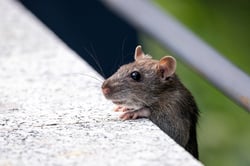
What Does It Cost to Get Rid of Mice?
Now understanding mice and their living habits, it stands to reason why this question is difficult to answer. There are a lot of factors that must be considered when calculating the cost of mice removal. How many mice are in your home? What damage has been caused? Are you attempting DIY mice removal? If seeking the help of a pro, do they guarantee their service? Does the pest professional just remove existing mice, or do they tackle prevention as well? These are all important questions to consider during the price comparison process.
DIY mice removal is often presented as the cheaper option. This may be true at face value, but rarely is it the most cost-efficient option in the long run. This is because DIY attempts may be unsuccessful at first and require a second, third, or even fourth treatment to see results. Even with effective results, DIY solutions don’t address damages caused by the mice, nor do they help in preventing future mice from getting into your home. This means despite spending just $40 on some mouse traps at first, you’re likely to incur additional and compounding costs in the future. Worse yet, ineffective or temporarily effective DIY solutions leave your home susceptible to continued damage from mice. Repairing these damages can very quickly skyrocket to several thousand dollars.
If you decide to hire a professional to address your mouse concerns, you’re likely to get a better bang for your buck. Still, we caution that you do your research before hiring just any old company. Some professionals that offer an enticingly low price point are doing so primarily because they offer no prevention protection and expect you to be calling them back next year for the same service because the mice returned.
We highly recommend you seek out a pest professional that takes the time to explain their process to you and encourages you to stay informed. Reputable and trustworthy companies should offer some sort of promise regarding the efficacy of their service. Services should offer long-term solutions and should never be a quick fix. Look for a company that not only treats for existing mice, but also sets a prevention plan in place to ensure your home stays protected.
EcoShield Pest Solutions offers an Exclusion Service that is 100% satisfaction guaranteed. Rodent exclusion is addressed with a holistic approach that not only rids your home of mice, but also offers long-term treatment plans and seals all entry points to your home. With an annual renewal, EcoShield promises to keep rodents out year-round. If the mice come back, so do we… at absolutely no cost to you!
Because of the range of mice removal options available and the severity of the infestation, there is no one-size-fits-all investment required to get rid of mice in your home. You may pay under $100 for DIY chemicals and mouse traps, $250-$500 to a local pest control company for a short term fix (with no guarantees), or $500-$1000+ for full mice removal, prevention, and remediation from a reputable company. However, there are many factors that go into the pricing such as do repairs to the foundation need to be made? Do garage door sweeps need to be replaced? Or have mice chewed holes though the walls and floors? All of these factors and the associated cost of repairs need to be considered in the cost of the service and to keep your home rodent-free.
If you’re experiencing mice in your home, don’t delay in calling trusted pest professionals like EcoShield. Call us today for a FREE no obligation quote!
